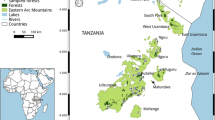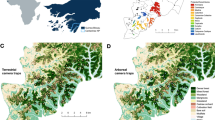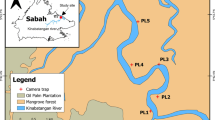Abstract
Tropical rainforest canopies harbor nearly half of the world’s biodiversity. Previous research on rainforest ecosystems has primarily focused on the terrestrial stratum, leading to a limited understanding of forest canopies. Camera traps have seen a wide application in the studies of terrestrial mammals, but their utility for documenting arboreal mammal communities has been far more limited. Financial resources, field training, and access to equipment and logistical constraints may have precluded researchers from undertaking systematic arboreal camera surveys, especially in the Global South countries. We deployed arboreal and terrestrial cameras to document the mammal assemblage in Kadumane estate, Western Ghats, India. During April–May 2022, we documented 3 exclusively arboreal, 11 semi-arboreal and 14 terrestrial species, using 16 cameras in the canopies and 13 cameras on the ground. Using rarefaction curves, we find that 648 trap-nights were sufficient to document all the arboreal species, while > 1350 trap-nights of additional effort would have been required to document all the terrestrial species in our study site. For each species, we generated an arboreality index (calculated from proportional capture rates) to gauge its propensity for arboreal habits. We also compared the efficacy of using different baits; species responses to shrimp–dry fish baits indicated a reduction in rodent captures when carnivore captures were higher. Our study deliberates on the resources, logistical considerations, and advantages of arboreal camera surveys to study mammal assemblages in forest canopies. Importantly, we highlight the utility of such surveys for understanding the ecology of rare, elusive, and hitherto under-studied species that may be threatened with extinction.






Similar content being viewed by others
Data availability
The datasets generated and analyzed as part of this study are available from the corresponding author on reasonable request.
References
Anderson DL, Koomjian W, French B, Altenhoff SR, Luce J (2015) Review of rope-based access methods for the forest canopy: safe and unsafe practices in published information sources and a summary of current methods. Methods Ecol Evol 6:865–872. https://doi.org/10.1111/2041-210X.12393
Anil G, Kishor N, Gafoor N, Ommer N, Nameer PO (2018) Observations on the Nilgiri marten Martes gwatkinsii (Mammalia: Carnivora: Mustelidae) from Pampadum Shola National Park, the southern Western Ghats, India. J Threat Taxa 10:11226–11230. https://doi.org/10.11609/jott.3446.10.1.11226-11230
Ansil BR, Mendenhall IH, Ramakrishnan U (2021) High prevalence and diversity of Bartonella in small mammals from the biodiverse Western Ghats. PLoS Negl Trop Dis 15:e0009178. https://doi.org/10.1371/journal.pntd.0009178
Ashton PS (1977) A contribution of rain forest research to evolutionary theory. Ann Missouri Bot Gard 64:694–705. https://doi.org/10.2307/2395295
Babu S, Jayson EA (2009) Anti-predator behaviour of large brown flying squirrel (Petaurista philippensis): is this an effective census method to survey the species? Curr Sci 96:772–773 http://www.jstor.org/stable/24104512. Accessed 14 Jan 2023
Basham EW, Baecher JA, Klinges DH, Scheffers BR (2023) Vertical stratification patterns of tropical forest vertebrates: a meta-analysis. Biol Rev 98:99–114. https://doi.org/10.1111/brv.12896
Benton MJ, Wilf P, Sauquet H (2022) The angiosperm terrestrial revolution and the origins of modern biodiversity. New Phytol 233:2017–2035. https://doi.org/10.1111/nph.17822
Bezerra BM, Bastos M, Souto A, Keasey MP, Eason P, Schiel N, Jones G (2014) Camera trap observations of nonhabituated critically endangered wild blonde capuchins, Sapajus flavius (Formerly Cebus flavius). Int J Primatol 35:895–907. https://doi.org/10.1007/s10764-014-9782-4
Blackwell GL, Potter MA, Minot EO (2001) Rodent and predator population dynamics in an eruptive system. Ecol Modell 142:227–245. https://doi.org/10.1016/S0304-3800(01)00327-1
Bowler MT, Tobler MW, Endress BA, Gilmore MP, Anderson MJ (2017) Estimating mammalian species richness and occupancy in tropical forest canopies with arboreal camera traps. Remote Sens Ecol Conserv 3:146–157. https://doi.org/10.1002/rse2.35
Cudney-Valenzuela SJ, Arroyo-Rodríguez V, Morante-Filho JC, Toledo-Aceves T, Andresen E (2023) Tropical forest loss impoverishes arboreal mammal assemblages by increasing tree canopy openness. Ecol Appl 33:e2744. https://doi.org/10.1002/eap.2744
Ganesh T, Devy MS (2006) Interactions between non-flying mammals and flowers of Cullenia exarillata Robyns (Bombacaceae), a canopy tree from the wet forests of Western Ghats, India. Curr Sci 90:1674–1679. http://www.jstor.org/stable/24091918. Accessed 14 Apr 2022
Godoy-Güinao J, Díaz IA, Celis-Diez JL (2018) Confirmation of arboreal habits in Dromiciops gliroides: a key role in Chilean temperate rainforests. Ecosphere 9:e02424. https://doi.org/10.1002/ecs2.2424
Gopal A, Mudappa D, Raman TRS, Naniwadekar R (2021) Seed fates of four rainforest tree species in the fragmented forests of Anamalais in the southern Western Ghats, India. Acta Oecol 110:103698. https://doi.org/10.1016/j.actao.2020.103698
Gregory T, Carrasco Rueda F, Deichmann J, Kolowski J, Alonso A (2014) Arboreal camera trap**: taking a proven method to new heights. Methods Ecol Evol 5:443–451. https://doi.org/10.1111/2041-210X.12177
Gregory T, Carrasco-Rueda F, Alonso A, Kolowski J, Deichmann JL (2017) Natural canopy bridges effectively mitigate tropical forest fragmentation for arboreal mammals. Sci Rep 7:1–11. https://doi.org/10.1038/s41598-017-04112-x
Haysom JK, Deere NJ, Wearn OR, Mahyudin A, Jami J, Reynolds G, Struebig MJ (2021) Life in the canopy: using camera-traps to inventory arboreal rainforest mammals in Borneo. Front For Glob 4:673071. https://doi.org/10.3389/ffgc.2021.673071
Hongo S, Dzefack Z, Vernyuy L, Minami S, Nakashima Y, Djiéto-Lordon C, Yasuoka H (2020) Use of multi-layer camera trap** to inventory mammals in rainforests in southeast Cameroon. Afr Study Monogr Suppl 60:21–37. https://doi.org/10.14989/250126
Hsieh TC, Ma KH, Chao A (2013) iNEXT: an R package for rarefaction and extrapolation of species diversity (Hill numbers). Methods Ecol Evol 7:1451–1456. https://doi.org/10.1111/2041-210X.12613
Jayasekara P, Weerasinghe U, Wijesundara D, Takatsuki S (2007) Identifying diurnal and nocturnal frugivores in the terrestrial and arboreal layers of a tropical rain forest in Sri Lanka. Ecotropica 13:7–15
Jha CS, Dutt CBS, Bawa KS (2000) Deforestation and land use changes in Western Ghats, India. Curr Sci 79:231–238. http://www.jstor.org/stable/24103455. Accessed 1 Jan 2023
Kays R, Allison A (2001) Arboreal tropical forest vertebrates: current knowledge and research trends. Plant Ecol 153:109–120. https://doi.org/10.1007/978-94-017-3606-0_9
Krishna CY, Karnad D (2010) New records of the Nilgiri marten Martes gwatkinsii in Western Ghats, India. Small Carniv Conserv 43:23–27
Kumara HN, Radhakrishna S (2013) Evaluation of census techniques to estimate the density of slender loris (Loris lydekkerianus) in Southern India. Curr Sci 104:1083–1086. http://www.jstor.org/stable/24092199. Accessed 25 Dec 2022
Laughlin MM, Martin JG, Olson ER (2020) Arboreal camera trap** reveals seasonal behaviors of Peromyscus spp. in Pinus strobus canopies. Am Midl Nat 183:210–222. https://doi.org/10.1637/0003-0031-183.2.210
Lowman M(M)D, Schowalter TD, Franklin JF (2012) Methods in forest canopy research. University of California Press. https://doi.org/10.1525/9780520953925
Lowman MD (2009) Canopy research in the twenty-first century: a review of arboreal ecology. Trop Ecol 50:125
MacGregor-Fors I, Payton ME (2013) Contrasting diversity values: statistical inferences based on overlap** confidence intervals. PLoS One 8:e56794. https://doi.org/10.1371/journal.pone.0056794
Maher J (2006) Canopy access: beyond basic single rope technique. Inst Trop Ecol Conserv pp 1–11. https://verticalsection.caves.org/nh/55/CanopyAccess.pdf. Accessed 18 Apr 2022
Menon V (2014) Indian mammals a field guide. Hachette India
Mills CA, Godley BJ, Hodgson DJ (2016) Take only photographs, leave only footprints: novel applications of non-invasive survey methods for rapid detection of small, arboreal animals. PLoS One 11:e0146142. https://doi.org/10.1371/journal.pone.0146142
Moffett MW (2000) What’s “Up”? A critical look at the basic terms of canopy biology. Biotropica 32:569–596. https://doi.org/10.1111/j.1744-7429.2000.tb00506.x
Moore JF, Soanes K, Balbuena D, Beirne C, Bowler M, Carrasco-Rueda F, Cheyne SM, Coutant O, Forget P-M, Haysom JK, Houlihan PR, Olson ER, Lindshield S, Martin J, Tobler M, Whitworth A, Gregory T (2021) The potential and practice of arboreal camera trap**. Methods Ecol Evol 12:1768–1779. https://doi.org/10.1111/2041-210X.13666
Nadkarni NM, Parker GG, Lowman MD (2011) Forest canopy studies as an emerging field of science. Ann For Sci 68:217–224. https://doi.org/10.1007/s13595-011-0046-6
Niedballa J, Sollmann R, Courtiol A, Wilting A (2016) camtrapR: an R package for efficient camera trap data management. Methods Ecol Evol 7:1457–1462. https://doi.org/10.1111/2041-210X.12600
Norman M (2003) Biodiversity hotspots revisiteD. Bioscience 53:916–917. https://doi.org/10.1641/0006-3568(2003)053[0916:BHR]2.0.CO;2
O’Connell AF, Nichols JD, Karanth KU (2011) Camera traps in animal ecology: methods and analyses. Springer
Oliveira-Santos LGR, Tortato MA, Graipel ME (2008) Activity pattern of Atlantic forest small arboreal mammals as revealed by camera traps. J Trop Ecol 24:563–567. https://doi.org/10.1017/S0266467408005324
Otani T (2001) Measuring fig foraging frequency of the Yakushima macaque by using automatic cameras. Ecol Res 16:49–54. https://doi.org/10.1046/j.1440-1703.2001.00370.x
Perry DR (1978) A method of access into the crowns of emergent and canopy trees. Biotropica 10:155–157. https://doi.org/10.2307/2388019
Ramachandra TV, Shivamurthy V, Aithal DB (2015) Environmental flow assessment in Yettinaholé: Where is 24 TMC to divert? Sahyadri Conservation Series 48. ENVIS Tech Rep 91. https://doi.org/10.13140/RG.2.1.5136.4323
Randler C, Katzmaier T, Kalb J, Kalb N, Gottschalk TK (2020) Baiting/luring improves detection probability and species identification—a case study of mustelids with camera traps. Animals 10:2178. https://doi.org/10.3390/ani10112178
Srivathsa A, Banerjee A, Banerjee S, Chawla MM, Das A, Ganguly D, Rodrigues RG, Adhya T, Bhatia S, Kshettry A, Majgaonkar I (2022) Chasms in charismatic species research: seventy years of carnivore science and its implications for conservation and policy in India. Biol Conserv 273:109694. https://doi.org/10.1016/j.biocon.2022.109694
Suzuki KK, Ando M (2019) Early and efficient detection of an endangered flying squirrel by arboreal camera trap**. 83:372–378. https://doi.org/10.1515/mammalia-2018-0055
Venkatesh B, Nayak PC, Thomas T, Jain SK, Tyagi JV (2021) Spatio-temporal analysis of rainfall pattern in the Western Ghats region of India. Meteorol Atmos Phys 133:1089–1109. https://doi.org/10.1007/s00703-021-00796-z
Vijay A, Chandran K, Hameed H (2022) First sighting record of the elusive Nilgiri marten Martes gwatkinsii in Wayanad, Southern Western Ghats, India. Mammalia 8:439–443. https://doi.org/10.1515/mammalia-2021-0119
Wardhaugh CW (2023) Forest canopy ecology: what do we know about canopy species and their interactions? CABI Rev. https://doi.org/10.1079/PAVSNNR201510039
Whitworth A, Beirne C, Pillco Huarcaya R, Whittaker L, Serrano Rojas SJ, Tobler MW, MacLeod R (2019) Human disturbance impacts on rainforest mammals are most notable in the canopy, especially for larger-bodied species. Divers Distrib 25:1166–1178. https://doi.org/10.1111/ddi.12930
Whitworth A, Braunholtz LD, Huarcaya RP, MacLeod R, Beirne C (2016) Out on a limb: arboreal camera traps as an emerging methodology for inventorying elusive rainforest mammals. Trop Conserv Sci 9:675–698. https://doi.org/10.1177/194008291600900208
Woodman N, Timm RM, Slade NA, Doonan TJ (1996) Comparison of traps and baits for censusing small mammals in neotropical lowlands. J Mammal 77:274–281. https://doi.org/10.2307/1382728
Acknowledgements
We thank the Nature Conservation Foundation, Mysore, for offering logistical support and the Kadumane Tea Estate, Karnataka, for granting us permission to carry out the study.
Funding
This study was funded by On the Edge Conservation, UK, through a grant to the Wildlife Biology and Conservation Program, National Centre for Biological Sciences–TIFR. A.S. was supported by the Department of Science and Technology–Government of India’s Innovation in Science Pursuit for Inspired Research Faculty Award.
Author information
Authors and Affiliations
Contributions
All authors contributed to the study conception and design; material preparation and data collection: ON; analysis: ON and VR; first draft of the manuscript was written by ON, AS, and VR; all authors read and approved the final manuscript.
Corresponding author
Ethics declarations
Ethics approval and consent to participate
The study was not conducted in any protected areas and did not require research permits. Since the methods used were non-invasive in nature, animal care and use committee approval was not required.
Competing interests
The authors declare no competing interests.
Additional information
Communicated by: Dries Kuijper
Publisher’s Note
Springer Nature remains neutral with regard to jurisdictional claims in published maps and institutional affiliations.
Supplementary information
ESM 1
(PDF 872 kb)
Rights and permissions
Springer Nature or its licensor (e.g. a society or other partner) holds exclusive rights to this article under a publishing agreement with the author(s) or other rightsholder(s); author self-archiving of the accepted manuscript version of this article is solely governed by the terms of such publishing agreement and applicable law.
About this article
Cite this article
Nazareth, O., Srivathsa, A. & Ramachandran, V. Trunks and treetops: integrating terrestrial and arboreal camera-trap surveys to document elusive mammal communities in India. Mamm Res 69, 43–52 (2024). https://doi.org/10.1007/s13364-023-00714-1
Received:
Accepted:
Published:
Issue Date:
DOI: https://doi.org/10.1007/s13364-023-00714-1




